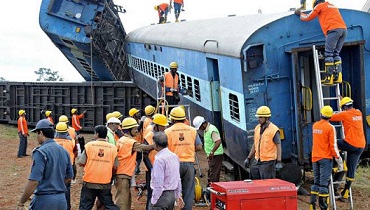DISASTER MANAGEMENT:

The Railway is a highly structured Organization, with a clear chain of command, effective communication channels and a time-tested pattern of working. During accidents, however, almost all these break down. It is in this situation that cool and clear thinking is necessary and decisions have to be taken quickly and effectively.
Disaster Management is the art of functioning under conditions of extreme difficulty. It is the ability to take cool rational decisions in a crisis situation filled with tension and even danger. It is the ability to function effectively when all known chains of command have been broken and when even channels of communication have failed. In short, it is the ability to function in chaos.
OBJECTIVES IN DEALING WITH ACCIDENTS:
The main objectives to be ensured while dealing with a serious accident are to:
- Save lives and alleviate suffering
- Protect property including mail
- Provide succor and help to passengers at the site of the accident
- Ascertain the cause of the accident
- Restore through lines of communication and Instill a sense of security and confidence in the minds of the affected people
PROTECTION :
ROLE OF GUARD, DRIVER AND STATION MASTER:
- The Guard and Driver shall immediately protect the affected train in case of single line and in case of double line/multiple lines shall do so after protecting the adjacent line first, by the use of flasher light, hand signals, detonators, fusee, etc. as detailed in G.R. 6.03/G.R. 9.10 as the case may be.
- The Station Master receiving information of an accident shall see that all necessary precautions are taken by the most expeditious means possible, for the protection of the affected train and traffic.
REPORTING:
ROLE OF GUARD, DRIVER AND STATION MASTER – ALL CONCERNED MESSAGES:
- On the occurrence of an accident the Guard or in his absence the Driver shall immediately note the time of the accident, and after protection shall report the occurrence to the Control and to the nearest Station Master.
- Wherever possible, protection and reporting shall be done simultaneously.
Report by the quickest available means:
- Every accident shall immediately be reported to the control or Station Master of the nearest (accessible) station by the quickest available means. For this purpose the Guard or in his absence the Driver or any other railway servant present at the site of the accident shall follow the procedure prescribed in S.R.6.05
- The station Master shall arrange to advise the controller, Station Master at the other end of the Block section and officials of the other departments also by the quickest possible means.
- The Station Masters/Station Managers of stations where sirens are provided shall arrange for sounding the siren immediately and arrange to move MRV/BD special where necessary.
Information to Civil and police authorities:
- The situation the Station Master shall also establish direct contact with Civil and Police authorities such as District Collector, District Superintendent of Police, Superintendent of Police GRP apart from conveying the information to the nearest Police Station.
PARTICULARS TO BE CONVEYED BY THE GUARD AND DRIVER OR ANY OFFICIAL AT THE SITE OF ACCIDENT WHILE CONVEYING FIRST INFORMATION:
- Time and date of an accident.
- Train number and description.
- Engine number.
- Driver’s name.
- Guard’s name.
- Section and kilometer of an accident.
- The condition of the adjacent track whether fouled or clear.
- The brief description of accident/nature of the accident.
- Whether any injury, number of persons injured/killed. Whether an injury is to passengers, railway staff or others.
- In case of derailment the number and type of vehicles derailed or capsized and in case of derailed vehicles, the particulars of wheels derailed, whether loaded or empty.
- If the engine has derailed the number and description of the wheels derailed.
- The condition of permanent way i.e., whether badly damaged or otherwise, length damaged, etc.
- Assistance required – MRV, break down cranes with tool vans, tool vans only, MFD, staff with tools only, etc.
- In case of level crossing accidents the type of road vehicle involved and the number of persons injured/dead and the nature of injuries.
- Whether the engine is disabled and whether any derailment has taken place.
- Whether road vehicle is entangled/obstructing the track.
- Prima facie cause of the accident, if known.Any other important information.
NOTE:
- The information should be precise and clear.
- In case of accidents involving passenger carrying trains and accidents at level crossing gates, the first information should be very prompt.
- In case there is no injury this should be clearly advised.
- Guard and Driver shall convey the report of an accident in Form Acc.3 in addition to the advice given by telephone.


